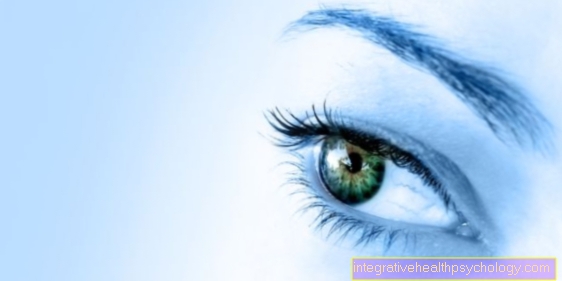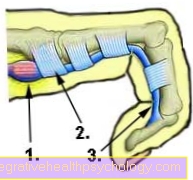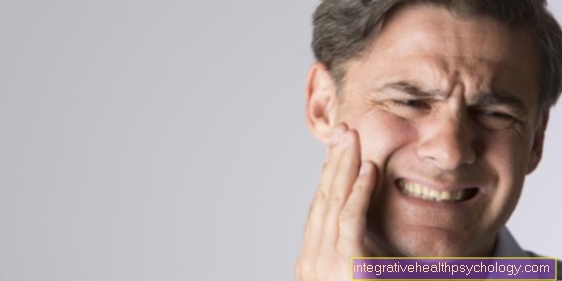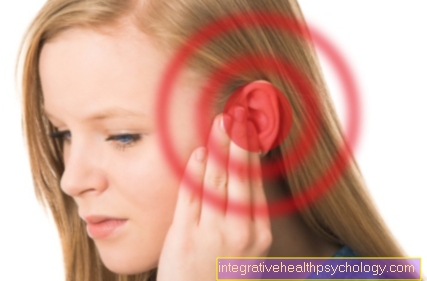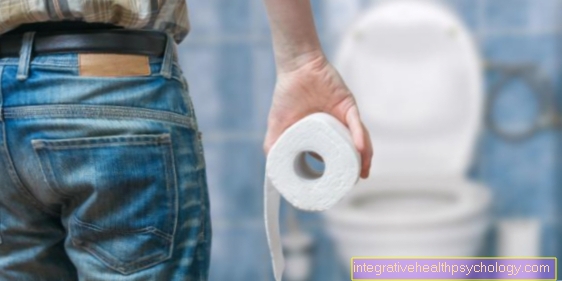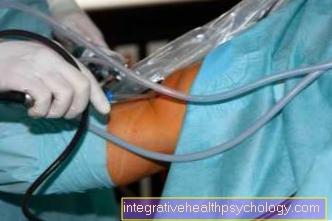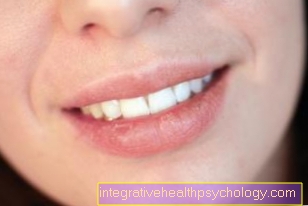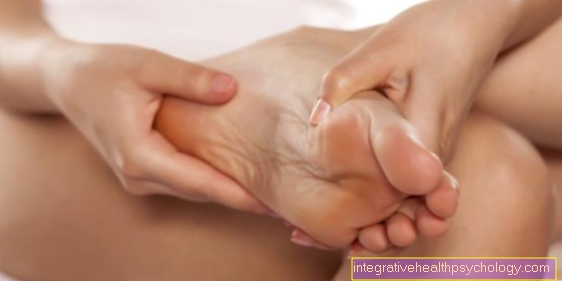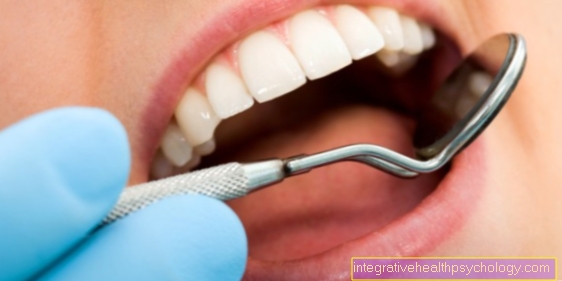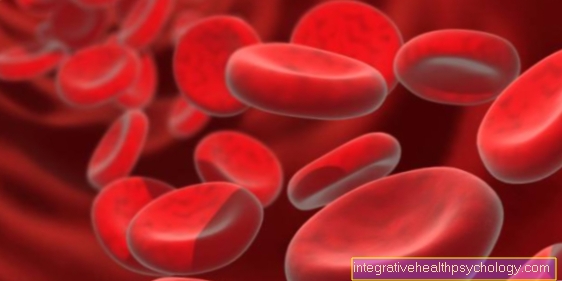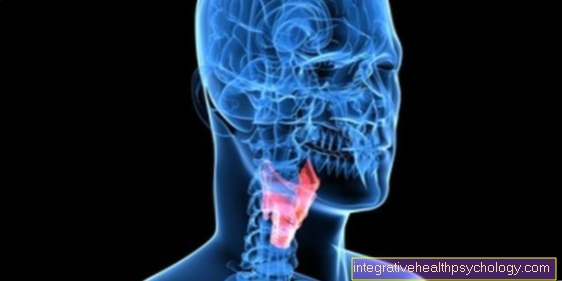Sebum on the eye
definition
The sebum glands belong to the appendages of the skin. They serve to produce and excrete a secretion, the so-called sebum. This has the task of protecting the skin from drying out and consists mainly of fats and proteins.
The Meibomian glands are a special form of the sebum glands on the eye. They are found on the back edge of the eyelid and produce the fat-rich portion of the tear film.

Anatomy of the sebum glands in the eye
The sebum glands are mainly found on the body in connection with the hair covers, the so-called follicles, or the hair roots. On the eye, these are the eyelashes. In addition, so-called "free sebum glands" are found on the eye, which are not related to follicles but occur isolated in the upper skin layers of the eyelids. The glands form small, sac-shaped clusters of cells on the sides of the follicles or in the upper layers of the skin.
In contrast to other glands, they do not have their own duct in which the cells excrete the secretion. Instead, the cells continue to fill up with secretion and are finally released to the outside as a whole. This form of release of substances is called holocrine.
The sebum is then carried out along the eyelashes and spreads over the skin of the eyelids. The secretion of the meibomian glands also mixes with the tear fluid.
For more detailed information on the anatomy of the sebum glands, see: Sebum
Function of sebum glands on the eye
The secretion of the sebum glands primarily has a protective function. Due to its high fat content, it protects the skin and hair from drying out.
It also makes them stable and more resistant to external influences. The sebum supports the natural barrier function of the skin and thus helps the defense against pathogens and harmful substances such as Chemicals.
The secretion of the meibomian glands is of particular importance. After being released from the glands, this combines with the tear fluid produced in the tear glands and forms the fat-rich part of the tear film. This is necessary to prevent the tear film from evaporating quickly. Only then can the cornea be adequately moistened and supplied with nutrients.
The tear fluid also serves to compensate for irregularities on the corneal surface, to a certain extent, and thus improve the optical properties of the eye. It also has a cleaning function for the eye.
All of this can only function optimally if the natural composition of the tear film is guaranteed by the unrestricted function of the various glands.
If the meibomian gland is permanently inflamed, a clinical picture occurs, which is called hailstone. This disease is completely harmless, but affects the cosmetic aspect. Read more about this topic under: Hailstone
Blocked sebum glands in the eye
Blockages of individual sebum glands on the eye are usually not noticed and usually resolve on their own. However, if the glandular secretion is not able to flow continuously, this is often expressed as an inflammation of the edge of the eyelid, a so-called blepharitis (Eyelid inflammation). A distinction is made between anterior blepharitis, which affects the sebum glands on the eyelashes, and posterior blepharitis, which is caused by an obstruction of the meimbom's glands.
The former is shown by greasy eyelashes, a waxy eyelid margin and flaking of the skin and itching. When the meimbom glands are relocated, there is often a foamy, tough and clearly thickened secretion on the edge of the eyelid. Furthermore, the impaired composition of the tear film always leads to dry eyes if there is no glandular secretion.
Since the protective function of the sebum is also reduced, infections of the eyelash base often occur, especially with bacteria. These infections are manifested by a significant swelling of the eyelid margins as well as redness and pain.
Therapeutically, antibiotics should be used if an infection with bacteria is present. For this purpose, antibiotic eye ointments are usually used. Furthermore, you should try to keep the eyes sufficiently moist with the help of eye drops. The adhesions of the gland outlets and the accumulation of secretions, however, can be treated with simple home remedies.
What home remedies can help?
When treating blocked sebum glands on the eye, eyelid margin hygiene is the main focus. A number of home remedies can be used for this. Carefully wiping over the edge of the eyelid with moistened cotton swabs or some baby shampoo can help remove flaking and accumulated secretion.
A range of special cleaning solutions as well as low-lint cotton pads and cleaning wipes are also available in pharmacies, which are ideal for eyelid hygiene. In general, care should be taken to use the cotton swabs or cleaning wipes only for one touch of the eyelid in order to prevent germs from spreading as much as possible.
In addition, you should only touch the skin very lightly and avoid rubbing the eyelid so that there is no further irritation of the already very sensitive skin.
In addition to the hygienic measures, the application of heat can help to support the emptying of the gland ducts and to reduce the swelling of the eyelid. Warm compresses as well as red lamps or special thermal goggles are particularly suitable for this.
Are you more interested in this topic? Read our next article below: Clogged sebum - what to do?
Homeopathy for clogged sebum glands
Various homeopathic medicines can also be used to treat eyelid inflammation caused by blocked sebum glands. However, this should only be done in addition to measures of eyelid margin hygiene. In addition, when infected with bacteria, homeopathic remedies cannot replace treatment with antibiotics.
The homeopathic remedies are usually available in the form of eye drops and contain belladonna, euphrasia, and mercurius. Since these can also have side effects, you should always pay close attention to possible exclusion criteria before using the preparations. It is advisable to consult a doctor.
What do lumps on the edge of the eyelid indicate?
Lumps on the edge of the eyelid or the sebum glands can have various causes. If there is reddening and accompanying pain, it may be an inflammation of the sebum glands, a so-called stye.
If the swelling is rather painless and not reddened, the cause can also be a congestion of the meimbom glands.
Other possible causes are e.g. Warts, benign connective tissue tumors (so-called fibromas), Cysts, cholesterol deposits but also malignant tumors.In any case, it is advisable to consult a doctor in order to weigh up the need for treatment.
Are you interested in this topic? Read more about this under: Stye
Inflammation of a sebum gland in the eye
A painful inflammation of the sebum glands on the eye is called a hordeolum in medicine. It is also popularly known under the term stye. Depending on which glands are inflamed, one speaks of an outer stye if the sebum glands of the eyelashes are affected and an inner stye if the inflammation originates from the meibomian glands.
Before the externally recognizable signs appear, such an inflammation often manifests itself a few days in advance with pain when moving the eyelid. In the course of this, the lids become reddened, usually nodular-like swelling and itchy. Since the lump is filled with pus and does not have much space to spread, it usually leads to an uncomfortable feeling of tension.
The inflammation is usually caused by bacteria. Therefore, care should be taken to ensure adequate hygiene and the affected lid should not be touched if possible in order to avoid the spread of the germs. In most cases, after a few days, the stye will burst on its own and the accumulated pus will drain away.
However, since there is always the risk of the inflammation spreading to the conjunctiva and the eye itself or the eye socket, it is advisable to consult a doctor, especially if the inflammation has not subsided by itself after a week at the latest.
Measures that positively influence the course and can accelerate the bursting of the stye are eyelid hygiene and heat applications, e.g. warm compresses or red light lamps.
For more detailed information on this topic, read our article under: Inflammation of the sebum - this must be observed!
How to express the sebum glands on the nipple
The nipples are a region of the body with a high density of sebum glands. These can become clogged with a strong secretion production. This can usually be seen from the outside as a white-yellowish point in the areola and also forms a small bump.
Similar to pus pimples on the face, you can try to empty the sebum glands by applying light pressure from two sides. This should be done carefully and under no circumstances should sharp instruments be used, as this carries a high risk of injury and subsequent inflammation.
In general, care should be taken to ensure adequate hygiene when expressing. It is recommended to clean the area afterwards with disinfectant.
Recommendations from the editorial team
Further general information on the subject of "sebum glands":
- Anatomy of the eye
- Sebum glands
- Overactive sebum - symptoms and treatment


